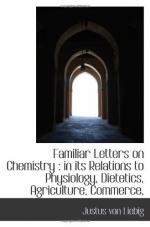These changes take place in the healthy animal body during every moment of life; a waste and loss of substance proceeds continually; and if this loss is to be restored, and the original weight and substance repaired, an adequate supply of materials must be furnished, from whence the blood and wasted tissues may be regenerated. This supply is obtained from the food.
In an adult person in a normal or healthy condition, no sensible increase or decrease of weight occurs from day to day. In youth the weight of the body increases, whilst in old age it decreases. There can be no doubt that in the adult, the food has exactly replaced the loss of substance: it has supplied just so much carbon, hydrogen, nitrogen, and other elements, as have passed through the skin, lungs, and urinary organs. In youth the supply is greater than the waste. Part of the elements of the food remain to augment the bulk of the body. In old age the waste is greater than the supply, and the body diminishes. It is unquestionable, that, with the exception of a certain quantity of carbon and hydrogen, which are secreted through the skin and lungs, we obtain, in the solid and fluid excrements of man and animals, all the elements of their food.
We obtain daily, in the form of urea, all the nitrogen taken in the food both of the young and the adult; and further, in the urine, the whole amount of the alkalies, soluble phosphates and sulphates, contained in all the various aliments. In the solid excrements are found all those substances taken in the food which have undergone no alteration in the digestive organs, all indigestible matters, such as woody fibre, the green colouring matter of leaves ( chlorophyle), wax, &c.
Physiology teaches us, that the process of nutrition in animals, that is, their increase of bulk, or the restoration of wasted parts, proceeds from the blood. The purpose of digestion and assimilation is to convert the food into blood. In the stomach and intestines, therefore, all those substances in the food capable of conversion into blood are separated from its other constituents; in other words, during the passage of the food through the intestinal canal there is a constant absorption of its nitrogen, since only azotised substances are capable of conversion into blood; and therefore the solid excrements are destitute of that element, except only a small portion, in the constitution of that secretion which is formed to facilitate their passage. With the solid excrements, the phosphates of lime and magnesia, which were contained in the food and not assimilated, are carried off, these salts being insoluble in water, and therefore not entering the urine.
We may obtain a clear insight into the chemical constitution of the solid excrements without further investigation, by comparing the faeces of a dog with his food. We give that animal flesh and bones—substances rich in azotised matter—and we obtain, as the last product of its digestion, a perfectly white excrement, solid while moist, but becoming in dry air a powder. This is the phosphate of lime of the bones, with scarcely one per cent. of foreign organic matter.




